Sir John Monash, Personal Files Book 1, 14 August - 3 November 1914 - Part 1
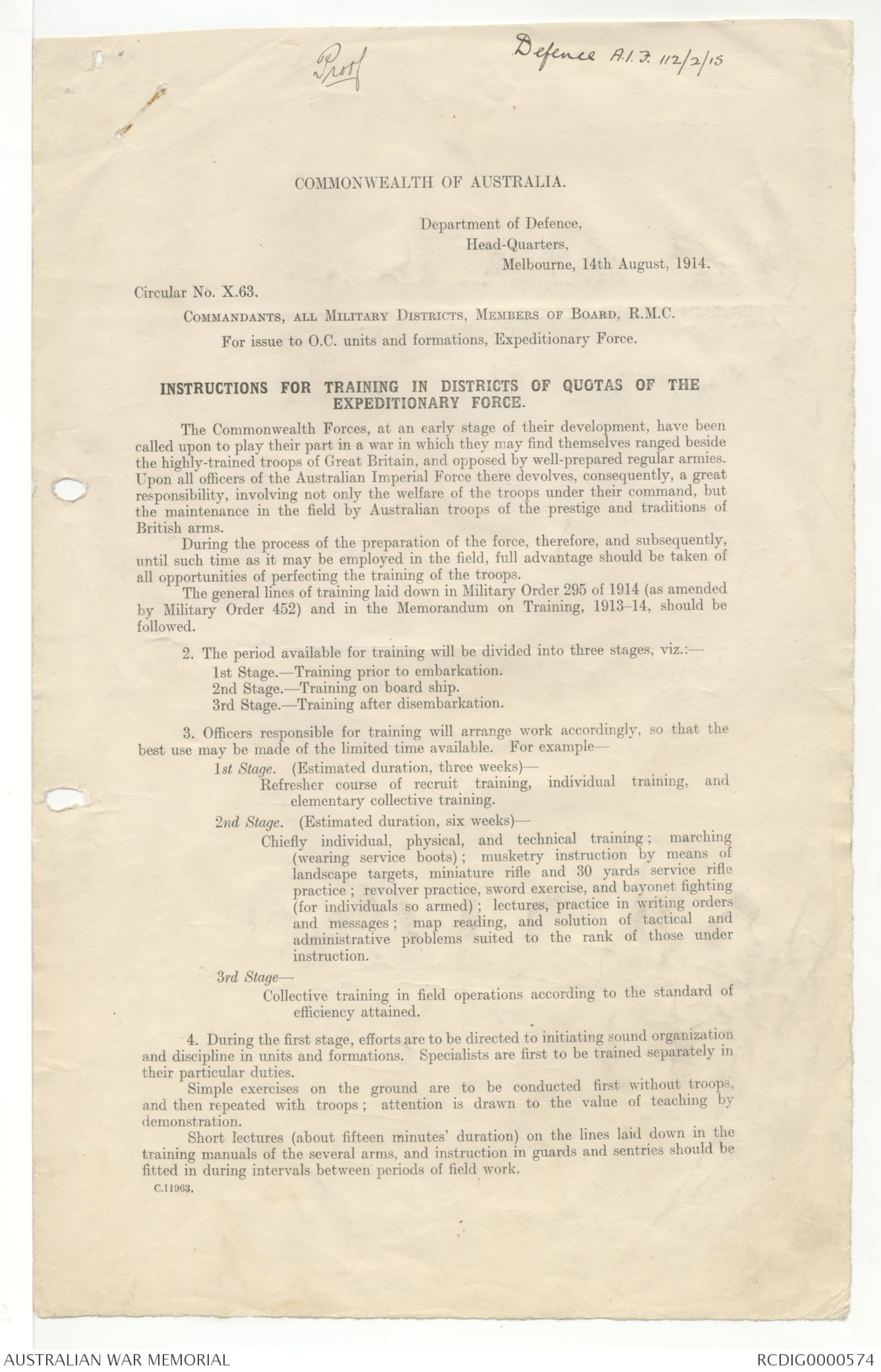
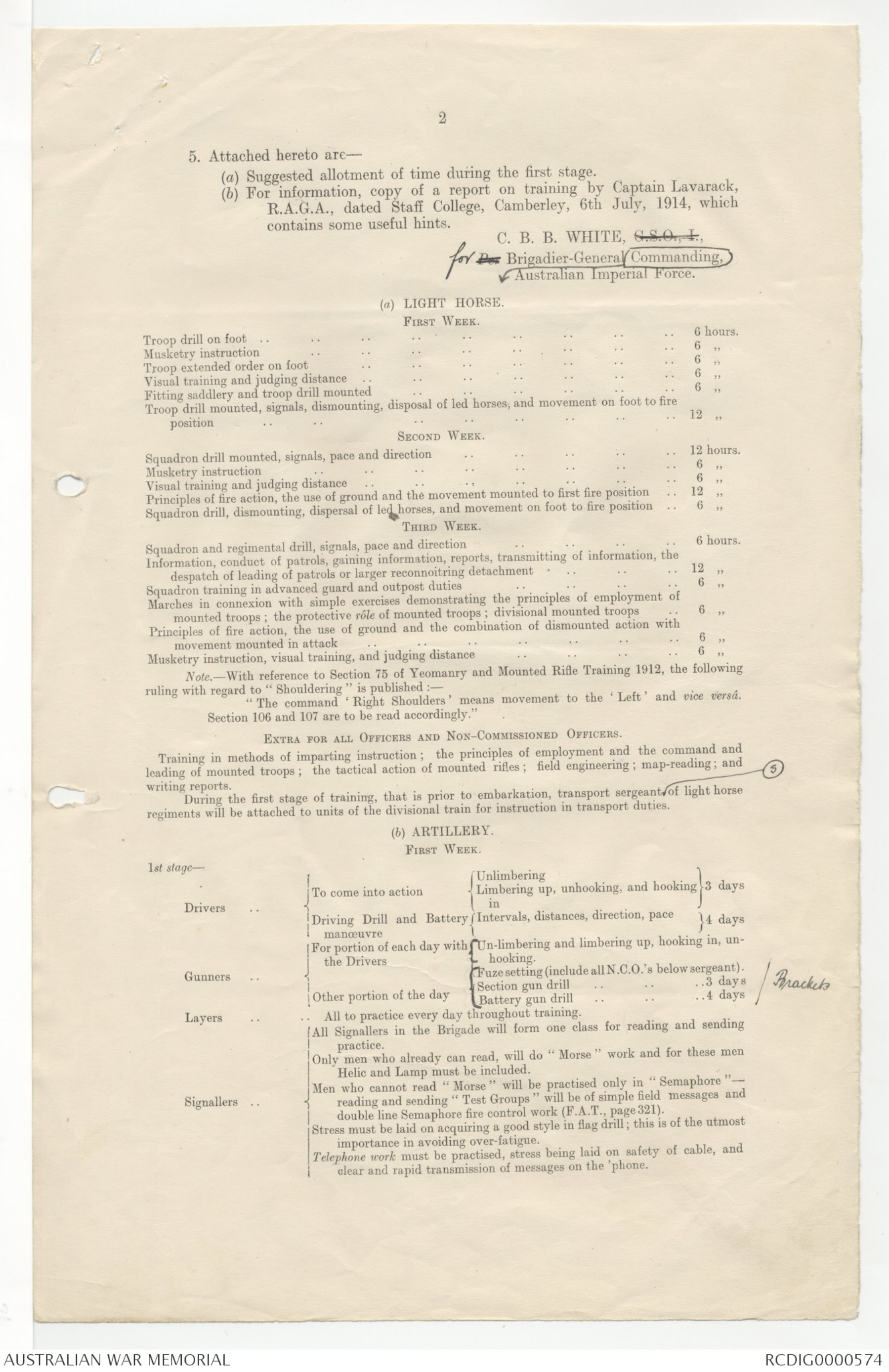
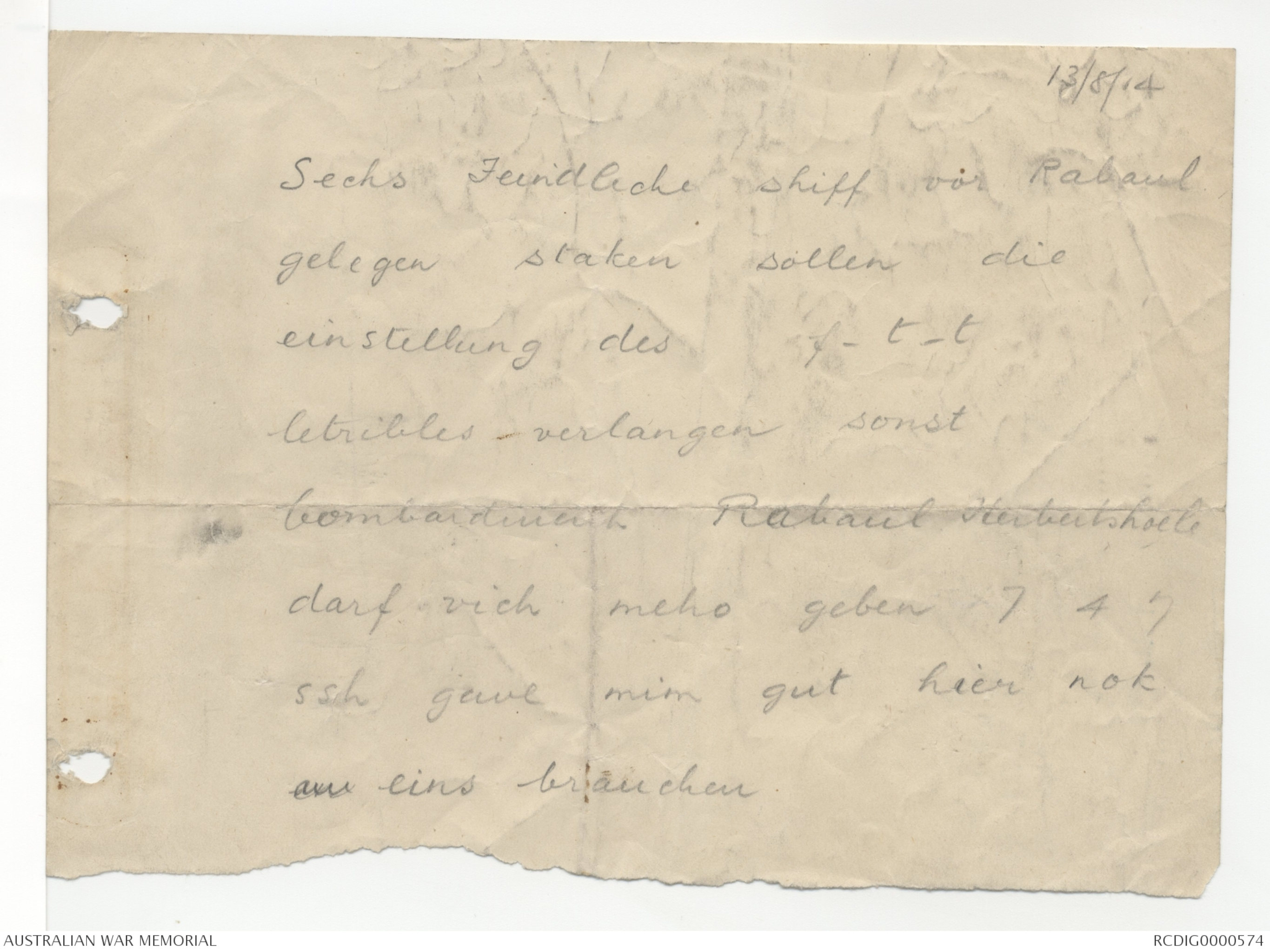
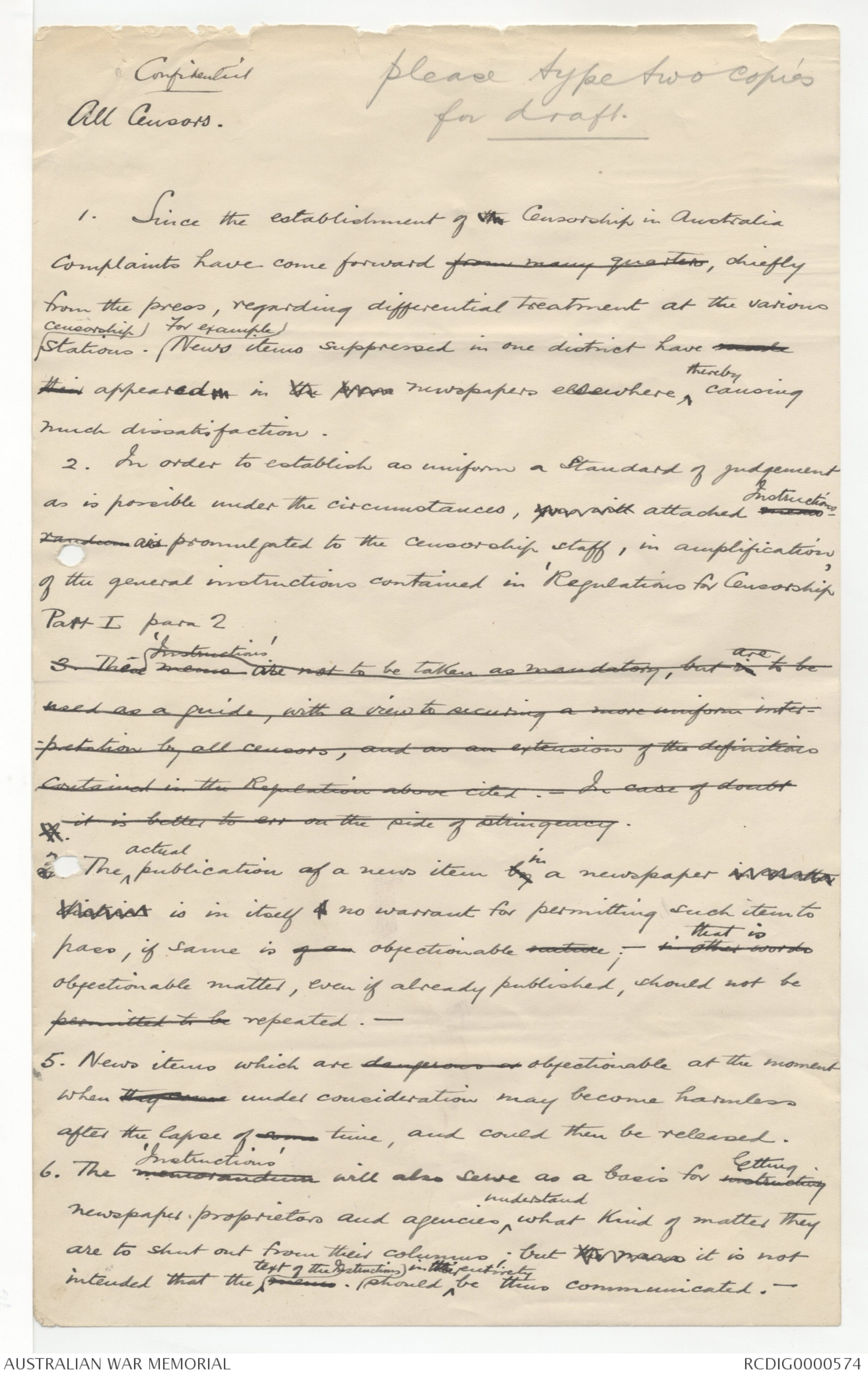
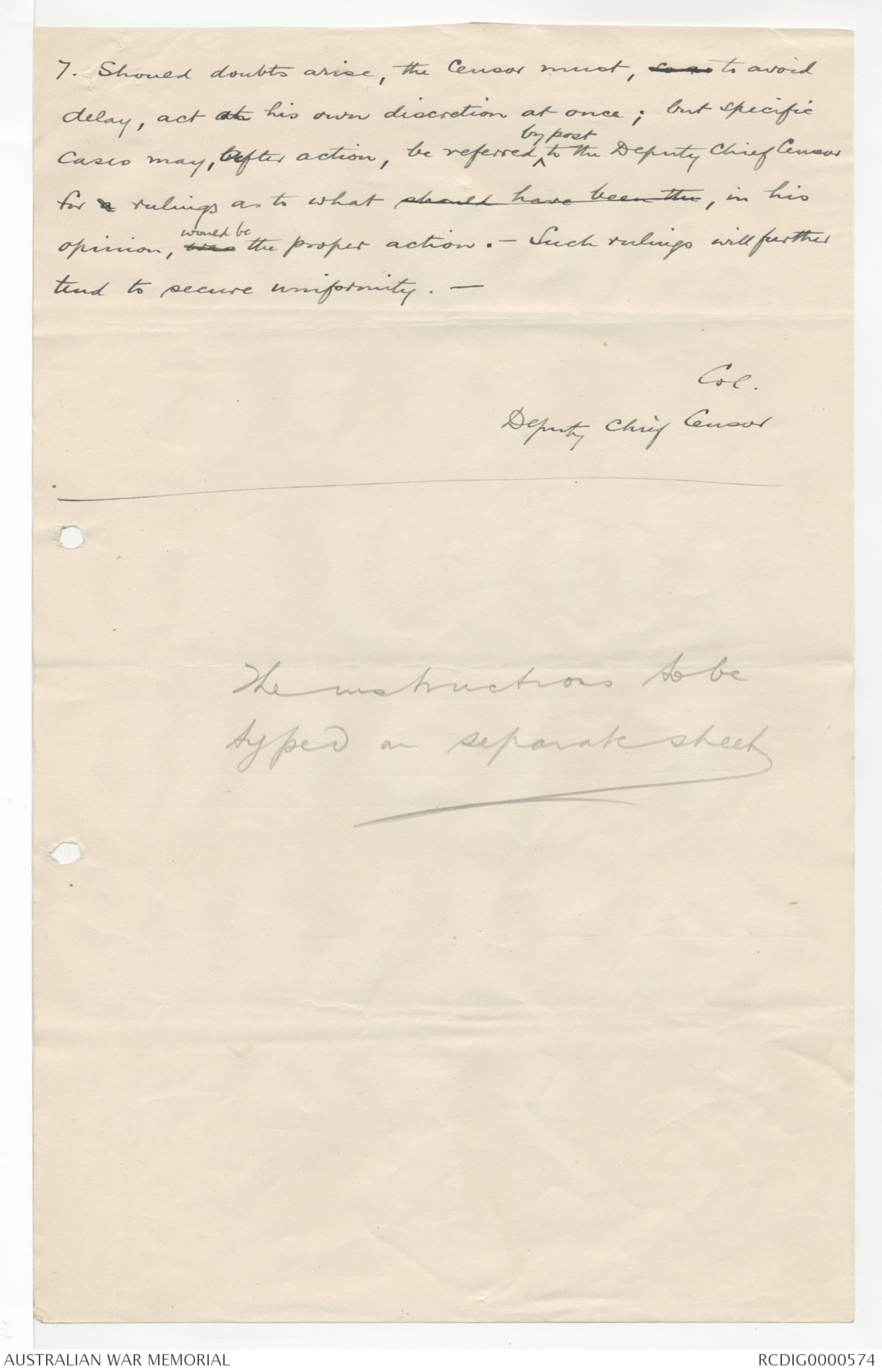
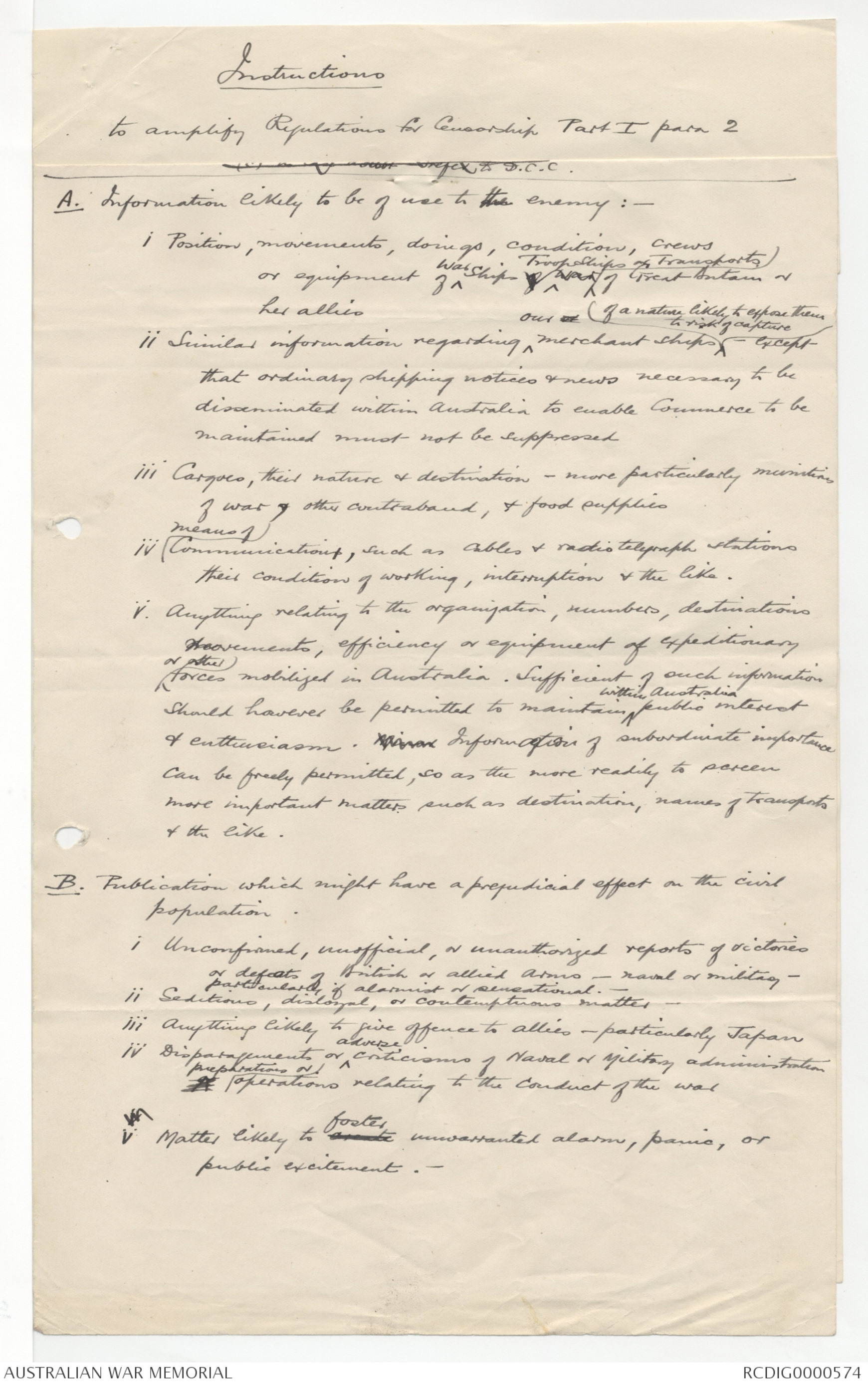
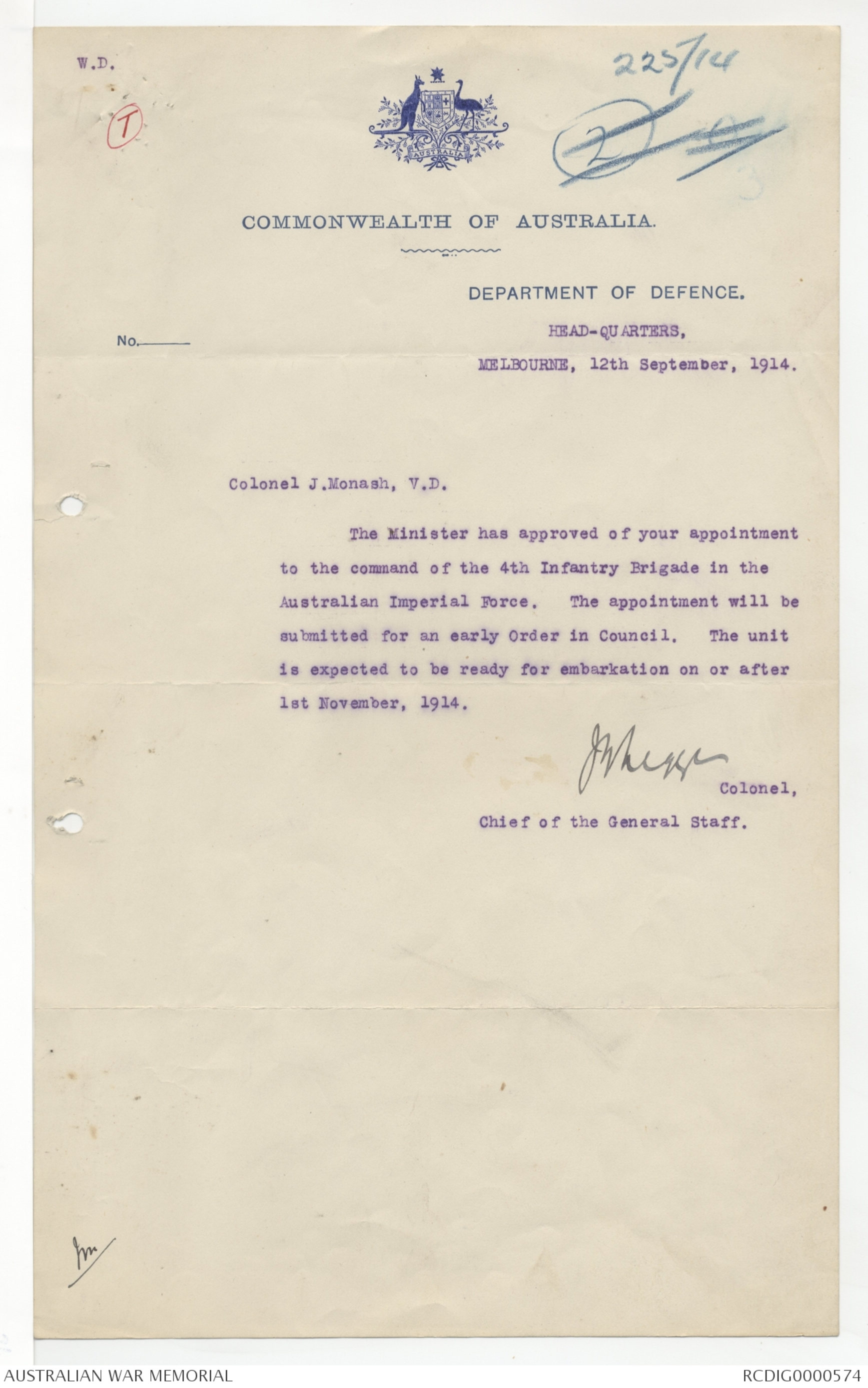
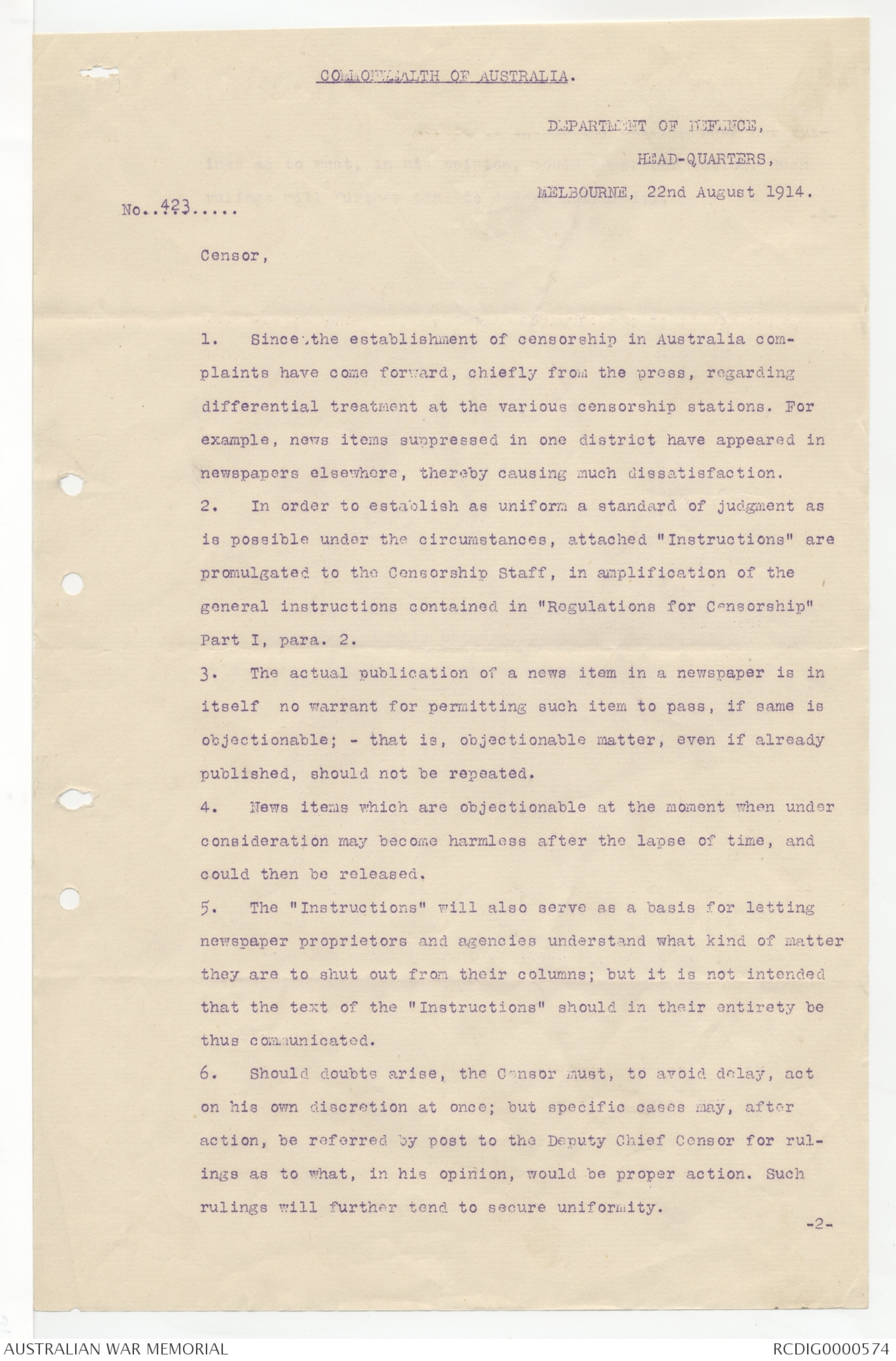
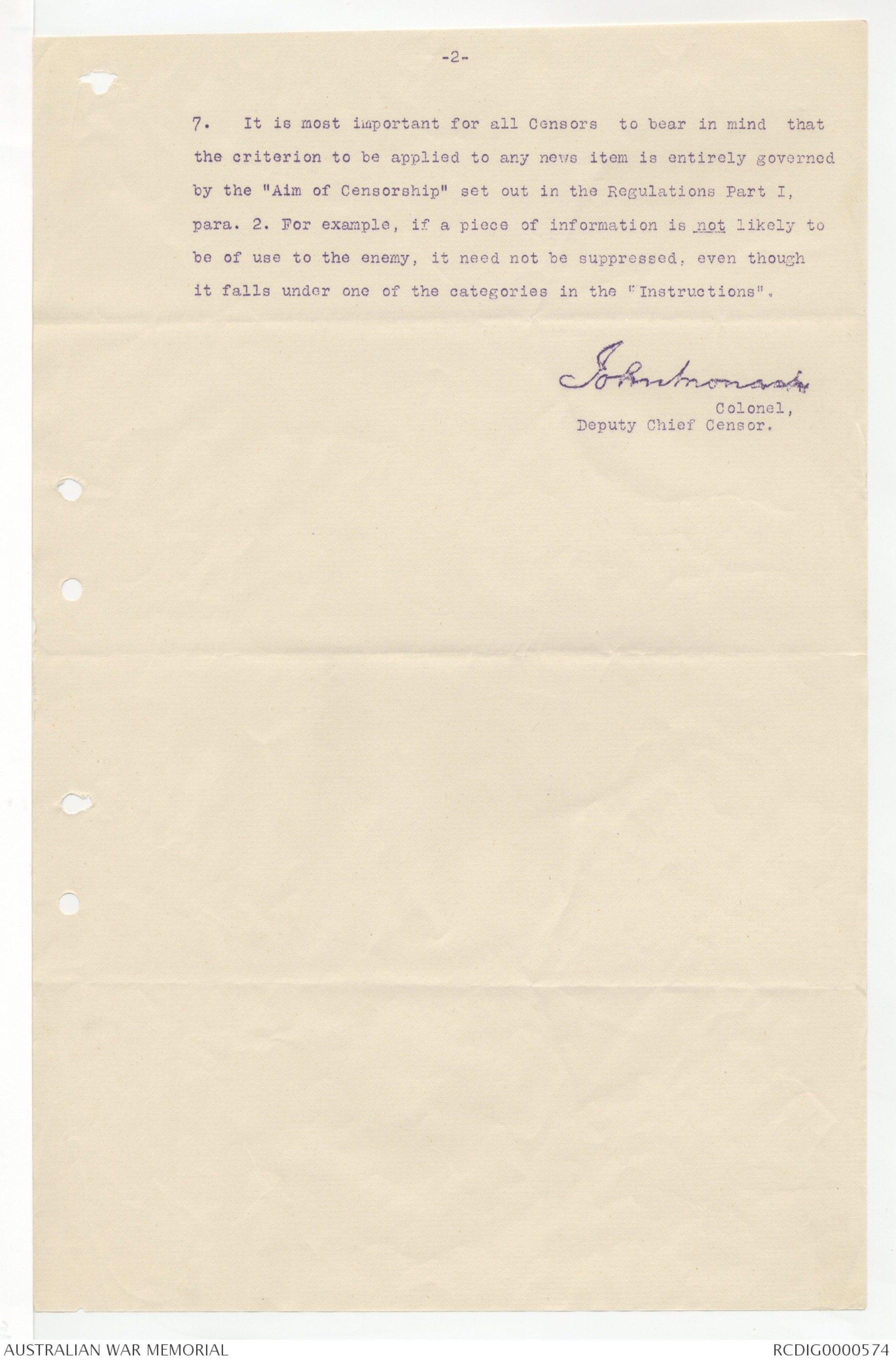
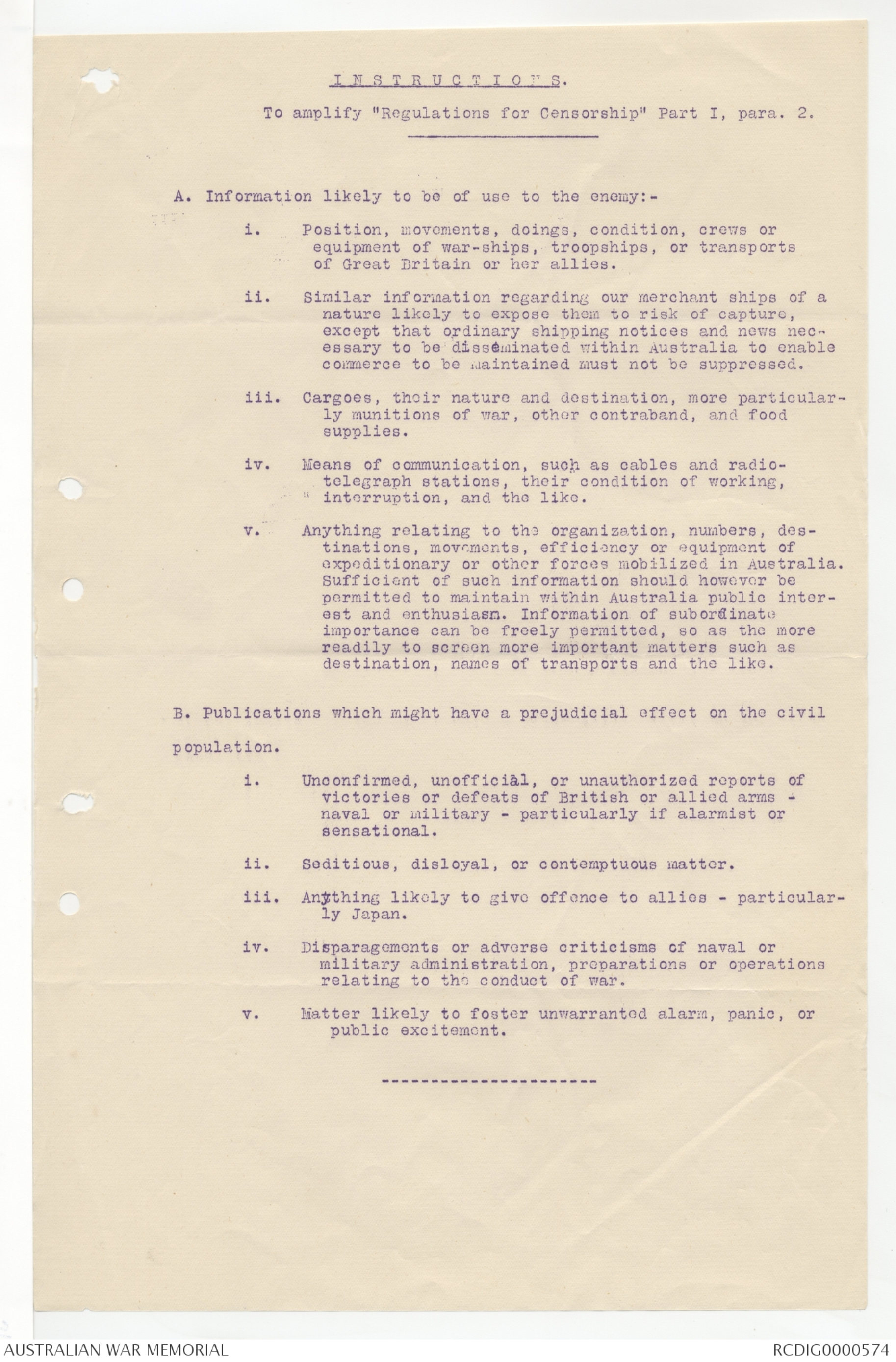
Proof Defence A.I.F. 112/2/158]
COMMONWEALTH OF AUSTRALIA.
Department of Defence,
Head-Quarters,
Melbourne, 14th August, 1914.
Circular No. X.63.
COMMANDANTS, ALL MILITARY DISTRICTS, MEMBERS OF BOARD, R.M.C.
For issue to O.C. units and formations, Expeditionary Force.
INSTRUCTIONS FOR TRAINING IN DISTRICTS OF QUOTAS OF THE
EXPEDITIONARY FORCE.
The Commonwealth Forces, at an early stage of their development, have been
called upon to play their part in a war in which they may find themselves ranged beside
the highly-trained troops of Great Britain, and opposed by well-prepared regular armies.
Upon all officers of the Australian Imperial Force there devolves, consequently, a great
responsibility, involving not only the welfare of the troops under their command, but
the maintenance in the field by Australian troops of the prestige and traditions of
British arms.
During the process of the preparation of the force, therefore, and subsequently,
until such time as it may be employed in the field, full advantage should be taken of
all opportunities of perfecting the training of the troops.
The general lines of training laid down in Military Order 295 of 1914 (as amended
by Military Order 452) and in the Memorandum on Training, 1913-14, should be followed.
2. The period available for training will be divided into three stages, viz.:-
1st Stage.—Training prior to embarkation.
2nd Stage.—Training on board ship.
3rd Stage.—Training after disembarkation.
3. Officers responsible for training will arrange work accordingly, so that the
best use may be made of the limited time available. For example -
1st Stage. (Estimated duration, three weeks)—
Refresher course of recruit training, individual training, and
elementary collective training.
2nd Stage. (Estimated duration, six weeks)—
Chiefly individual, physical, and technical training; marching
(wearing service boots); musketry instruction by means of
landscape targets, miniature rifle and 30 yards service rifle
practice; revolver practice, sword exercise, and bayonet fighting
(for individuals so armed); lectures, practice in writing orders
and messages; map reading, and solution of tactical and
administrative problems suited to the rank of those under
instruction.
3rd Stage—
Collective training in field operations according to the standard of
efficiency attained.
4. During the first stage, efforts are to be directed to initiating sound organization
and discipline in units and formations. Specialists are first to be trained separately in
their particular duties.
Simple exercises on the ground are to be conducted first without troops,
and then repeated with troops; attention is drawn to the value of teaching by
demonstration.
Short lectures (about fifteen minutes' duration) on the lines laid down in the
training manuals of the several arms, and instruction in guards and sentries should be
fitted in during intervals between periods of field work,
C11963.
2
5. Attached hereto are—
(a) Suggested allotment of time during the first stage.
(b) For information, copy of a report on training by Captain Lavarack,
R.A.G.A., dated Staff College, Camberley, 6th July, 1914, which
contains some useful hints.
C. B. B. WHITE, C.S.0., I.,
for Per Brigadier General Commanding,
Australian Imperial Force.
(a) LIGHT HORSE.
FIRST WEEK.
Troop drill on foot .. .. .. .. .. .. .. .. .. 6 hours.
Musketry instruction .. .. .. .. .. .. .. .. 6 "
Troop extended order on foot .. .. .. .. .. .. .. 6 "
Visual training and judging distance .. .. .. .. .. .. 6 "
Fitting saddlery and troop drill mounted .. .. .. .. .. .. 6 "
Troop drill mounted, signals, dismounting, disposal of led horses, and movement on foot to fire
position .. .. .. .. .. .. .. .. 12 "
SECOND WEEK.
Squadron drill mounted, signals, pace and direction .. .. .. .. 12 hours.
Musketry instruction .. .. .. .. .. .. .. .. 6 "
Visual training and judging distance .. .. .. .. .. .. 6 "
Principles of fire action, the use of ground and the movement mounted to first fire position 12 "
Squadron drill, dismounting, dispersal of led horses, and movement on foot to fire position 6 "
THIRD WEEK.
Squadron and regimental drill, signals, pace and direction .. .. .. .. 6 hours.
Information, conduct of patrols, gaining information, reports, transmitting of information, the
despatch of leading of patrols or larger reconnoitring detachment .. .. .. 12 "
Squadron training in advanced guard and outpost duties .. .. .. .. 6 "
Marches in connexion with simple exercises demonstrating the principles of employment of
mounted troops ; the protective rőle of mounted troops; divisional mounted troops .. 6 "
Principles of fire action, the use of ground and the combination of dismounted action with
movement mounted in attack .. .. .. .. .. .. .. 6 "
Musketry instruction, visual training, and judging distance .. .. .. 6 "
Note.—With reference to section 75 of Yeomanry and Mounted Rifle Training 1912, the following
ruling with regard to "Shouldering" is published:—
"The command 'Right Shoulders' means movement to the 'Left' and vice versa.
Section 106 and 107 are to be read accordingly."
EXTRA FOR ALL OFFICERS AND NON-COMMISSIONED OFFICERS.
Training in methods of imparting instruction; the principles of employment and the command and
leading of mounted troops; the tactical action of mounted rifles; field engineering; map-reading; and
writing reports.
During the first stage of training, that is prior to embarkation, transport sergeants of light horse [*S*]
regiments will be attached to units of the divisional train for instruction in transport duties.
(b) ARTILLERY.
FIRST WEEK.
1st stage—
| Drivers .. | {To come into action | Unlimbering {Limbering up, unhooking, and hooking in |
} 3 days |
| {Driving Drill and Battery manoeuvre |
{Intervals, distances, direction, pace |
} 4 days | |
| Gunners .. |
{For portion of each day with the Drivers |
{Un-limbering and limbering up, hooking in, unhooking. |
|
| {Other portion of the day | {Fuze setting (include all N.C.O.'s below sergeant). Section gun drill .. .. .. Battery gun drill .. .. .. |
3 days 4 days [*Brackets*] |
|
| Layers .. All to practice every day throughout training. | |||
| Signallers .. | All Signallers in the Brigade will form one class for reading and sending practice. Only men who already can read, will do "Morse" work and for these men Helic and Lamp must be included. { Men who cannot read "Morse" will be practised only in "Semaphore" __ reading and sending "Test Groups" will be of simple field messages and double line Semaphore fire control work (F.A.T., page 321). Stress must be laid on acquiring a good style in flag drill; this is of the utmost importance in avoiding over-fatigue. Telephone work must be practised, stress being laid on safety of cable, and clear and rapid transmission of messages on the 'phone. |
||
13/8/14
Sechs Feindliche Shiff vor Rabaul
gelegen staken sollen die
einstellung des f - t - t
letribles -verlangen sonst
bombardmensh Rabaul Heibertshoele
darf vich meho geben 7 4 7
ssh gave mim gut hier nok
aw eins brauchen
Confidential
please type two copies
for draft.
All Censors.
1. Since the establishment of the Censorship in Australia
complaints have come forward from many quarters, chiefly
from the press, regarding differential treatment at the various
censorship Stations. For example News items suppressed in one district have made their appeared in the press newspapers elsewhere thereby causing
much dissatisfaction.
2. In order to establish as uniform a Standard of judgement
as is possible under the circumstances, you will attached memo Instructionsrandom are promulgated to the censorship staff, in amplification
of the general instructions contained in 'Regulations for Censorship'
Part 1 para 23. These 'Instructions" memos are not to be taken as mandatory. but is ^are to be used as a guide, with a view to securing a more uniform interpretation by all censors, and as an extension of the definitions contained in the Regulation above cited. - In case of doubt it is better to err on the side of stringency. 4.
3. The actual publication of a news item by ^in a newspaper in mattdistress is in itself to no warrant for permitting such item to
pass, if same is of an objectionable nature.- in other words ^that is
objectionable matter, even if already published, should not bepermitted to be repeated. -
5. News items which are dangerous objectionable at the moment
when they come under consideration may become harmless
after the lapse of some time, and could then be released.
6. The memorandum 'Instructions' will also serve as a basis for instructing letting
newspaper proprietors and agencies understand what kind of matter they
are to shut out from their columns; but the memo it is not
intended that the ^text of the Instructions memos should ^in the entirety be thus communicated. -
7. Should doubt arise, the Censor must, so as to avoid
delay, act at on his own discretion at once; but specific
cases may, after action, be referred by post to the Deputy Chief Censor
for a rulings as to what should have been the, in his
opinion, was would be the proper action.— Such rulings will further
tend to secure uniformity.—
Col.
Deputy Chief Censor
The instructions to be
typed on separate sheet
Instructions
to amplify Regulations for Censorship Part I para 2xxx xxxx xxxx refer to D.C.C.
A. Information likely to be of use to the enemy: -
i Position, movements, doings, condition, crews
or equipment of War Ships of war Troopships of Transports of Great Britain or
her allies.
ii Similar information regarding our merchant ships of a nature likely to expose them to risk of capture - except
that ordinary shipping notices & news necessary to be
disseminated within Australia to enable Commerce to be
maintained must not be suppressed
iii Cargoes, their nature & destination - more particularly munitions
of war, other contraband, & food supplies
iv Means of Communications, such as Cables & radio telegraph stations
their condition of working, interruption & the like.
v. Anything relating to the organization, numbers, destinations
movements, efficiency or equipment of expeditionary
or other forces mobilized in Australia. Sufficient of such information
should however be permitted to maintain within Australia public interest
& enthusiasm. Minor Information of subordinate importance
can be freely permitted, so as the more readily to screen
more important matters such as destination, names of transports
& the like.
B. Publication which might have a prejudicial effect on the Civil
population
i Unconfirmed, unofficial, or unauthorized reports of victories
or defeats of British or allied Arms - naval or military -
particularly if alarmist or sensational. -
ii Seditious, disloyal, or contemptuous matter -
iii Anything likely to give offence to allies – particularly Japan
iv Disparagements or adverse criticisms of Naval or Military administration
preparations of operations relating to the conduct of the warV
v Matter likely to create foster unwarranted alarm, panic, or
public excitement. -
W.D. 225/14 2 0
T
COMMONWEALTH OF AUSTRALIA.
DEPARTMENT OF DEFENCE.
No.__________
HEAD-QUARTERS.
MELBOURNE, 12th September, 1914.
Colonel J. Monash, V.D.
The Minister has approved of your appointment
to the command of the 4th Infantry Brigade in the
Australian Imperial Force. The appointment will be
submitted for an early Order in Council. The unit
is expected to be ready for embarkation on or after
1st November, 1914.
J W Legge
Colonel,
Chief of the General Staff.
JM
COMMONWEALTH OF AUSTRALIA.
DEPARTMENT OF DEFENCE,
HEAD-QUARTERS,
MELBOURNE, 22nd August 1914.
No. 423
Censor,
1. Since the establishment of censorship in Australia com-
plaints have come forward, chiefly from the press, regarding
differential treatment at the various censorship stations. For
example, news items suppressed in one district have appeared in
newspapers elsewhere, thereby causing much dissatisfaction.
2. In order to establish as uniform a standard of judgment as
is possible under the circumstances, attached "Instructions" are
promulgated to the Censorship Staff, in amplification of the
general instructions contained in "Regulations for Censorship"
Part I, para. 2.
3. The actual publication of a news item in a newspaper is in
itself no warrant for permitting such item to pass, if same is
objectionable; - that is, objectionable matter, even if already
published, should not be repeated.
4. News items which are objectionable at the moment when under
consideration may become harmless after the lapse of time, and
could then be released.
5. The "Instructions" will also serve as a basis for letting
newspaper proprietors and agencies understand what kind of matter
they are to shut out from their columns; but it is not intended
that the text of the "Instructions" should in their entirety be
thus communicated.
6. Should doubts arise, the Censor must; to avoid delay, act
on his own discretion at once; but specific cases may, after
action, be referred by post to the Deputy Chief Censor for rulings
as to what, in his opinion, would be proper action. Such
rulings will further tend to secure uniformity.
-2-
-2 -
7. It is most important for all Censors to bear in mind that
the criterion to be applied to any news item is entirely governed
by the "Aim of Censorship" set out in the Regulations Part I,
para. 2. For example, if a piece of information is not likely to
be of use to the enemy, it need not be suppressed, even though
it falls under one of the categories in the "Instructions".
JohnMonash
Colonel,
Deputy Chief Censor.
I N S T R U C T I O N S.
To amplify "Regulations for Censorship" Part I, para. 2.
A. Information likely to be of use to the enemy:-
i. Position, movements, doings, condition, crews or
equipment of war-ships, troopships, or transports
of Great Britain or her allies.
ii. Similar information regarding our merchant ships of a
nature likely to expose them to risk of capture,
except that ordinary shipping notices and news
necessary to be disseminated within Australia to enable
commerce to be maintained must not be suppressed.
iii. Cargoes, their nature and destination, more particularly
munitions of war, other contraband, and food
supplies.
iv. Means of communication, such as cables and radio-
telegraph stations, their condition of working,
interruption, and the like.
v. Anything relating to the organization, numbers,
destinations, movements, efficiency or equipment of
expeditionary or other forces mobilized in Australia.
Sufficient of such information should however be
permitted to maintain within Australia public interest
and enthusiasm. Information of subordinate
importance can be freely permitted, so as the more
readily to screen more important matters such as
destination, names of transports and the like.
B. Publications which might have a prejudicial effect on the civil
population.
i. Unconfirmed, unofficial, or unauthorized reports of
victories or defeats of British or allied arms -
naval or military - particularly if alarmist or
sensational.
ii. Seditious, disloyal, or contemptuous matter.
iii. Anything likely to give offence to allies - particularly
Japan.
iv. Disparagements or adverse criticisms of naval or
military administration, preparations or operations
relating to the conduct of war.
v. Matter likely to foster unwarranted alarm, panic, or
public excitement.
 Jacqueline Kennedy
Jacqueline KennedyThis transcription item is now locked to you for editing. To release the lock either Save your changes or Cancel.
This lock will be automatically released after 60 minutes of inactivity.